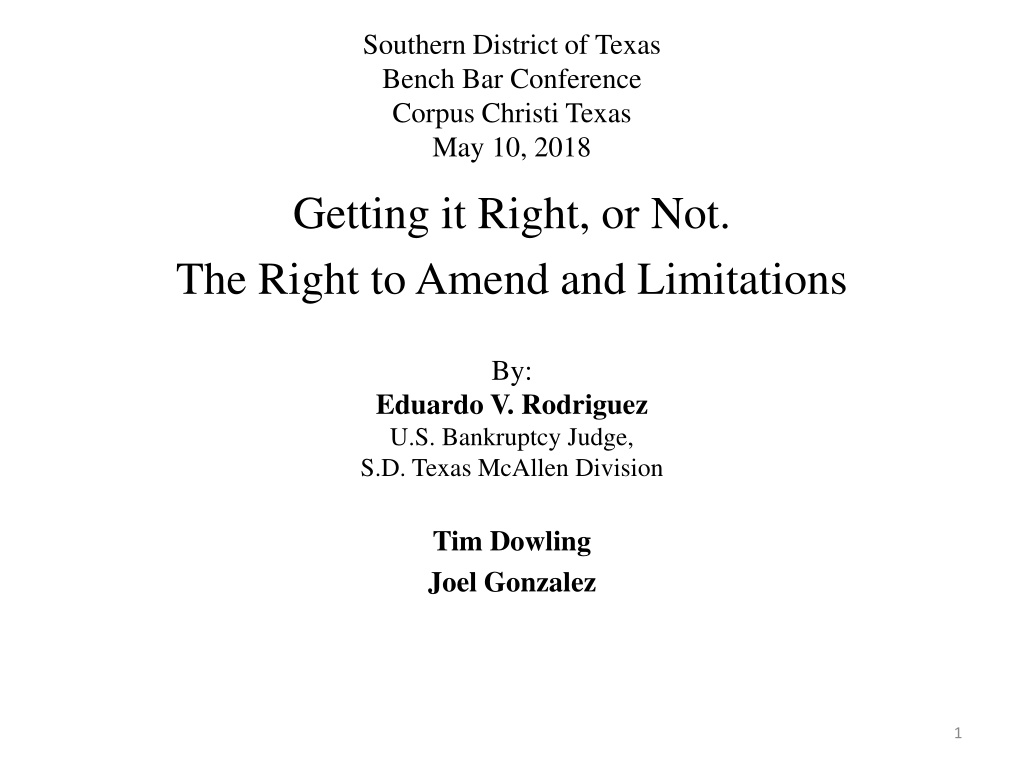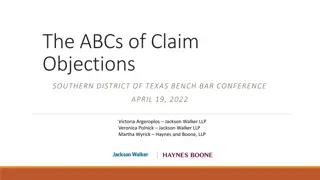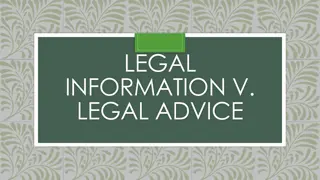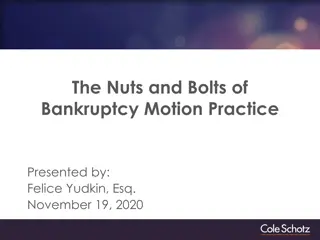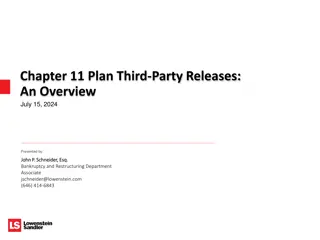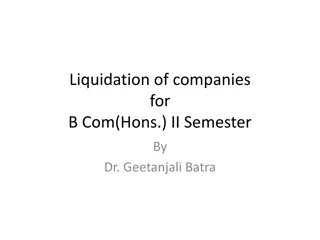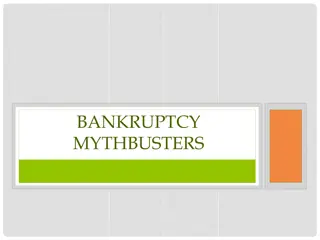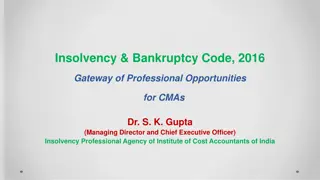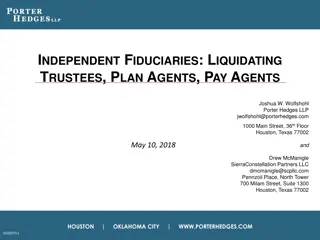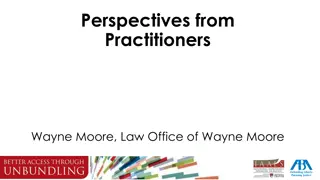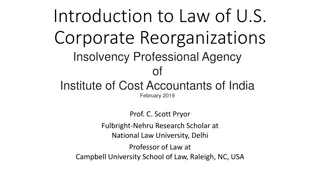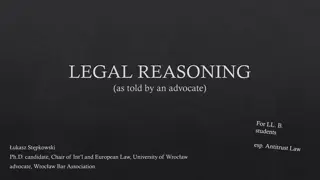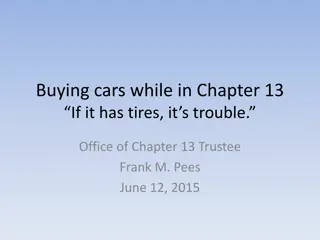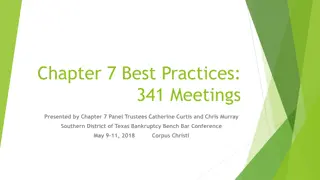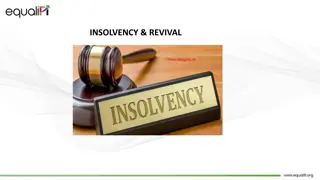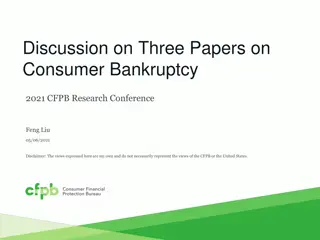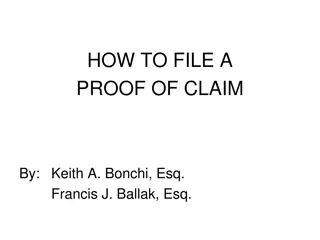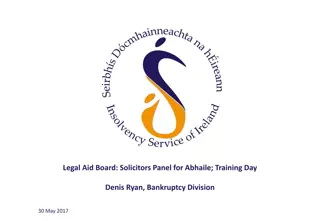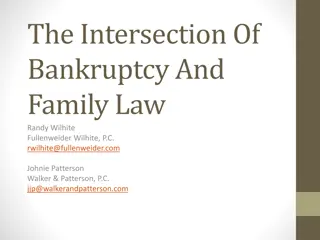Understanding Important Legal Concepts in Bankruptcy Cases
Explore key aspects of bankruptcy law, including time limits for filing supplemental schedules, rescinding reaffirmation agreements, and amending statements of intention. A hypothetical scenario illustrates complexities of cross-collateralized secured claims in Chapter 7 cases. Gain insights from expert presentations at the Southern District of Texas Bench Bar Conference.
Download Presentation

Please find below an Image/Link to download the presentation.
The content on the website is provided AS IS for your information and personal use only. It may not be sold, licensed, or shared on other websites without obtaining consent from the author. Download presentation by click this link. If you encounter any issues during the download, it is possible that the publisher has removed the file from their server.
E N D
Presentation Transcript
Southern District of Texas Bench Bar Conference Corpus Christi Texas May 10, 2018 Getting it Right, or Not. The Right to Amend and Limitations By: Eduardo V. Rodriguez U.S. Bankruptcy Judge, S.D. Texas McAllen Division Tim Dowling Joel Gonzalez 1
B.R. 1007(h) (Lists, Schedules, Statements, & Other Documents: Time Limits) If, as provided by 541(a)(5) of the Code, the debtor acquires or becomes entitled to acquire any interest in property, the debtor shall within 14 days after the information comes to the debtor's knowledge or within such further time the court may allow, file a supplemental schedule in the chapter 7, 11, 12 or 13 case; If the property is exempt, claim the exemption; Duty to supplement continues until case is closed; Property acquired after an order confirming a chapter 11 plan or a discharge entered in a 12 or 13 case does not require that a supplemental schedule be filed. 2
11 U.S.C. 524(c)(4) (Effect of Discharge) Reaffirmation agreements may be rescinded prior to discharge or within 60 days after the reaffirmation was filed with the court ---whichever occurs later (HARD DEADLINE) 3
Bankruptcy Rule 1009(b) The debtor may amend the statement of intention at any time before time period provided in 521(a). 521(a): a debtor must file the statement of intention within 30 days from petition date or on or before the date of the First meeting of creditors whichever is earlier, or within such additional time as the court for cause fixes. 4
Hypothetical No.1 (Chapter 7 Case) Fifth Wheel: Does the debtor have any recourse after he reaffirms a secured claim that is cross-collateralized with another debt he failed to reaffirm? Debtor owns a car and a 5th Wheel Fifth Wheel is financed by Credit Union Also has unsecured loan at the Credit Union Fifth Wheel is reaffirmed 2 weeks after conclusion of 341 Discharge is granted Fifth Wheel is repossessed 2 weeks after discharge (due to cross- collateralization with unsecured debt that was not reaffirmed) Bank refuses payment arrangements. 5
Hypothetical No.1 (Chapter 7 Case) Applicable Rules or Law? B.R. 1009(b) the statement of intention may be amended by the debtor at any time before the expiration of the period provided in 521(a)(2) of the Code (within 30 days after petition date or on or before the 341 meeting whichever is earlier or as within such additional time as the court for cause within such period fixes. 11 USC 524(c)(4) allows a debtor the right to rescind a reaffirmation agreement prior to discharge or within 60 days after the reaffirmation was filed with the court, whichever occurs later. Outcome: Debtor is out of time to amend Statement of Intention. Although the discharge order has been issued, it has been less than 60 days since the reaffirmation agreement was filed and the debtor has time to rescind. The debtor should file a proper notice of rescission and notify the creditor. 6
11 U.S.C. 523(a)(3) (Exceptions to Discharge) A discharge under 727, 1141, 1228(a), 1228(b) or 1328(b) of this title does not discharge an individual debtor from any debt 3)neither listed nor scheduled under 521(a)(1) of this title, with the name, if known to the debtor, of the creditor to whom such debt is owed, in time to permit-- (A) if such debt is not of a kind specified in paragraph (2), (4), or (6) of this subsection, timely filing of a proof of claim, unless such creditor had notice or actual knowledge of the case in time for such timely filing; (2) for money, property or services, obtained by fraud, or use of a statement in writing that is false, respecting the debtor s financial condition (4) for fraud or defalcation while acting in a fiduciary capacity (6) for willful and malicious injury by the debtor to another or 7
11 U.S.C. 523(a)(3) (B) if such debt is of a kind specified in paragraph (2), (4), or (6) of this subsection, timely filing of a proof of claim and timely request for a determination of dischargeability of such debt under one of such paragraphs, unless such creditor had notice or actual knowledge of the case in time for such timely filing and request; 8
Hypothetical No.1A (Chapter 7 Case) Fifth Wheel: Was the Debtor required to list the VA as a creditor if all the VA did was provide a guarantee to the credit union that it would pay if the Debtor did not? Assuming the Debtor was required to list the VA, may the VA reduce the disability payments? A year goes by and Debtor applies for Veterans Disability benefits and is approved for partial disability. However, the VA began garnishing his disability income because it had guaranteed the loan for the Fifth Wheel. Debtor remembers a few days after filing his case that the VA had guaranteed the loan. Debtor informs his attorney and an amended Schedule F was filed before the 341 notice was mailed. Debtors counsel did not send a separate notice. 9
Hypothetical No.1A (Chapter 7 Case) Applicable Rules or Law? A chapter 7 discharge discharges all debts that arose prior to the petition date except as provided in 523. See 11 U.S.C. 727(b). Note that 727(b) does not qualify the discharge as to listed or unlisted debts. Outcome: it depends if the case was a no asset case and on whether the debt was of the kind described on 523(a)(2), 523(a)(4), or 523(a)(6). [But see 523(a)(3) debts not listed or scheduled in time to permit the timely filing of a proof of claim, and the determination of dischargeability of such debt] If statutory exceptions as outlined in 523(a) do not apply, then it should not affect whether the debt is discharged. See Judd v. Wolfe, 78 F.3d 110 (3d Cir. 1996). Accord In re Beezley, 994 F.2d 1433 (9th Cir. 1993). 10
Bankruptcy Rule 1009(a) (Amendments of voluntary Petitions, Lists, Schedules & Statements) Petition, List, Schedules, or Statements May be amended at any time before case is closed Notice of amendment must be provided to: Trustee and entities affected by amendment Amendment is not absolute and subject to good faith test 11
Hypothetical No.2 (Chapter 11 Case) The UltimateAmendment, was a bankruptcy case ever filed? You are meeting for the first time the owner of a small family corporation on the Wednesday after foreclosure Tuesday. Owner tells you that his corporation owns very valuable real estate that was scheduled for foreclosure Tuesday, but he filed a pro-se chapter 11 case Monday evening. He did not inform the foreclosing bank of the bankruptcy filing, and the foreclosure occurred the next day. You agree to represent the corporation, but you are concerned that since a corporation cannot file bankruptcy pro-se, the Monday bankruptcy filing may not have rendered the next day foreclosure ineffective. 12
Hypothetical No.2 (Chapter 11 Case) What results after you file an amended bankruptcy petition with your signature on Wednesday? Will this amended petition relate back to the Monday bankruptcy filing, thereby rendering the Tuesday foreclosure ineffective? Applicable Rules or Law? In re IFC Credit Corp., 663 F.3d 315 (7th Cir. 2011) (Posner, J.). The Seventh Circuit held that Bankruptcy Rule 1009(a) authorizes relation back of your Wednesday amended petition to the Monday improper pro se bankruptcy filing by the corporation. Id. at 321. [See also Rule 15(c) Relation Back] Outcome: The amended petition will relate back Nuc pro tunc is not a substitute for relation back. It can t be used to revise history; only to correct inaccurate records. 13
11 U.S.C. 348(f)(1) (Effect of Conversion) Except as provided in paragraph (2), when a case under chapter 13 of this title is converted to a case under another chapter under this title (A) property of the estate in the converted case shall consist of property of the estate, as of the date of filing of the petition, that remains in the possession of or is under the control of the debtor on the date of conversion (2) If the debtor converts a case under chapter 13 of this title to a case under another chapter under this title in bad faith, the property of the estate in the converted case shall consist of the property of the estate as of the date of conversion. 14
Hypothetical No.3 (Chapter 13 Case) Mobile Home: Debtor s Chapter 13 hardship discharge vs. conversion to Chapter 7 Chapter 13 Debtor is in her 3rd year of a 5 year plan in which her mobile home and car are being paid through the plan. Car has been fully paid off in the plan. Mobile home destroyed by a hurricane and even with an insurance claim there will remain a deficiency Debtor lost her second job and will not be able to secure another one. Debtor wants to know her options in obtaining a discharge early. Convert to 7 or ?? 15
Hypothetical No.3 (Chapter 13 Case) Applicable Rules or Law? 1328: If a debtor s Chapter 13 case is dismissed or converted into a Chapter 7 case, a creditor s lien is reinstated, and the lien-avoiding effect of a confirmed plan, while established at confirmation, is contingent upon a discharge. 11 U.S.C. 1328; Victorio v. Billingslea, 470 B.R. 545 (S.D. Cal. 2012). 11 U.S.C. 348(f) Except as provided in paragraph (2), when a case under chapter 13 of this title is converted to a case under another chapter under this title (B) valuations of property and of allowed secured claims in the chapter 13 case shall apply only in a case converted to a case under chapter 11 or 12, but not in a case converted to a case under chapter 7, 16
Hypothetical No.3 (Chapter 13 Case) Outcome: Apply for a hardship discharge pursuant 11 U.S.C. 1328(b). (b) Subject to subsection (d), at any time after the confirmation of the plan and after notice and a hearing, the court may grant a discharge to a debtor that has not completed payments under the plan only if-- (1) the debtor's failure to complete such payments is due to circumstances for which the debtor should not justly be held accountable; (2) the value, as of the effective date of the plan, of property actually distributed under the plan on account of each allowed unsecured claim is not less than the amount that would have been paid on such claim if the estate of the debtor had been liquidated under chapter 7 of this title on such date; and (3) modification of the plan under section 1329 of this title is not practicable. 1328(b) 17
11 U.S.C. 1306 (Property of The Estate) (a) Property of the estate includes, in addition to the property specified in section 541 of this title (1) all property of the kind specified in such section that the debtor acquires after the commencement of the case but before the case is closed, dismissed, or converted to a case under chapter 7, 11, or 12 and (2) earnings from services performed by the debtor after the commencement of the case but before the case is closed, dismissed, or converted to a case under chapter 7, 11, or 12 of this title, whichever occurs first. 18
Hypothetical No.4 (Chapter 13 Case) Can a debtor amend her schedules to claim a different homestead after the initiallychosenone is sold during her bankruptcy case? Home No. 1 is a home in the city, is expensive and has no equity; Home No. 2 is an 80 acre ranch in the country and is lien free; Debtor files chapter 13 and exempts her city home as her homestead; No objections to her homestead exemption were lodged; Debtor Loses her job, sells the city home for the amount of the lien and moves to the country, converts to chapter 7 and exempts her 80 acre ranch as her homestead; Permissible? 19
Hypothetical No.4 (Chapter 13 Case) Applicable Rules or Law: Zibman Snapshot Rule: Any exemptions claimed are determined by the facts and the law as they exist on the date of filing the bankruptcy petition. In re Zibman, 268 F.3d 298, 302 (5th Cir. 2001). Under the snapshotrule, exemptions are determined as of bankruptcy filing date, but where debtor sold homestead three months before filing bankruptcy and did not reinvest the proceeds within six months, the proceeds lost their exempt character. Frost: Similarly where a Chapter 13 debtor sold his homestead post- petition and did not reinvest the proceeds within six months, the proceeds lost their exempt status. In re Frost, 744 F.3d 384, 387 (5th Cir. 2014). 20
Hypothetical No.4 (Chapter 13 Case) Applicable Rules or Law: Zibman and Frost stand for the proposition that if a debtor is eligible for a state law exemption at the time he files bankruptcy but the debtor fails to comply with the State s requirements for remaining eligible for that exemption throughout the entirety of the bankruptcy case, then the debtor loses the exemption. Brown: Neither Zibman nor Frost holds that a debtor may become eligible for an exemption that was originally unavailable to him when circumstances change during the pendency of the bankruptcy. In re Brown, 807 F.3d 701, 709-10 (5th Cir. 2015). 21
Hypothetical No.4A (Chapter 7 Case) Can a debtor amend her schedules to claim a different homestead after the initiallychosenone is sold during her chapter 7 bankruptcy case? Same as Hypo as above except: Home No. 1 is a home in the city, is expensive and has no equity; Home No. 2 is an 80 acre ranch in the country and is lien free; Debtor files chapter 7 and exempts her city home as her homestead; No objections to her homestead exemption were lodged; Debtor loses her job, sells the city home for the amount of the lien and moves to the country, converts to chapter 7 and exempts her 80 acre ranch as her homestead; 22
Hypothetical No.4A (Chapter 7 Case) In re Deberry, 884 F.3d 526 (5th Cir. 2018), that a Chapter 7 debtor could sell his homestead post-petition and then use the proceeds as he chooses (the debtor in Deberry divided the substantial net equity between his wife and his lawyers; bless his heart). He was not required to reinvest the net sales proceeds within six months of the sale. Accord In re Montemayor, 547 B.R. 684 (Bankr. S.D. Tex. 2016) (Rodriguez, J.) (exhaustive analysis of this issue). 23
Hypothetical No.4A (Chapter 13 Case) Note that in Chapter 7 homestead proceeds generated from a post-petition homestead sale that are not used to acquire a new homestead within six months do not lose their exempt status whereas they do if: (1) the Chapter 7 Debtor sold his homestead pre-petition and did not reinvest the proceeds in a new homestead within six months thereafter (the result in Zibman), or (2) a Chapter 13 debtor sold his homestead post-petition and did not reinvest the proceeds in another homestead within six months (the result in Frost) (and presumably the same result in Chapter 11 for an individual debtor due to the inclusion of post-petition earnings, etc. due to section 1115 of the Code). See In re Hawk, 871 F.3d 287 (5th Cir. 2017)(proceeds of exempt IRA assets liquidated after filing Chapter 7 do not lose their exempt status.) 24
Hypothetical No.4A (Chapter 13 Case) Outcome? Cannot claim 2 homesteads. In this scenario the Chapter 7 trustee should be able to sell the ranch as property of the estate since the Debtor cannot exempt it as her homestead. See In re Harris, 2016 WL 6127515 (Bankr. S.D. Tex. 2016) (Isgur. J.) ( snapshotrule means that all exemptions are determined at the time the bankruptcy petition is filed, and they do not change due to subsequent events ); accord Zibman at 302 ( any exemptions claimed are determined by the facts and the law as they exist on the date of filing the bankruptcy petition ). 25
Hypothetical No.4B (Chapter 7 Converted to Chapter 13) Can a Chapter 7 debtor sell his home post-petition that has substantial equity, not spend the equity, convert to Chapter 13, and correctly claim the proceeds as exempt? Can a debtor achieve a result by this approach he could not achieve due to Frost if he had filed Chapter 13? Arguably he can since the exemptionssnapshot is taken on the bankruptcy filing date, not the date of conversion to 13. See 11 U.S.C. 348(a); see also Johnson v Home State Bank, 501 U.S. 78, 111 S.Ct. 2150 (1991) (serial filings of Chapter 7 and 13 not categorically prohibited); In re Saylors, 869 F.2d. 1434 (11th Cir. 1989) (filing Chapter 13 before Chapter 7 case is closed not dispositive on the question of bad faith); butsee In re Cowan, 235 B.R.912 (Bankr.W.D. Mo.1999) (discussing factors to consider to determine whether filing Chapter 13 after a Chapter 7 discharge is in good faith; one factor is whether a result would be accomplished that is not permitted in either Chapter alone). 26
Hypothetical No.4B (Chapter 7 Case) Outcome?: The proceeds would be exempt due to the Deberry Snapshot that was taken when the chapter 7 was filed, but these proceeds may be considered disposable income that will have to be paid into the chapter 13 plan. In re Ortiz Paredo, 573 B.R. 703 (Bankr. W.D. Tex. 2017) The Debtor has an absolute right to convert to Chapter 7 (absent bad faith). See 11 U.S.C. 1307(a), Marrama v. Citizens Bank of Massachusetts, 549 U.S. 365, 127 S.Ct. 1105 (2007) (debtor forfeited right to convert from 7 to 13 due to bad faith). 27
Hypothetical No.4C (Chapter 13 Conversion to Chapter 7) Can a chapter 13 debtor covert to chapter 7, then sell his home, and keep the sales proceeds he has not reinvested in a new homestead when the chapter 7 trustee, relying on Frost, demands them? Debtor relies on Deberry to claim that since the sale occurred during chapter 7 he can keep them, and he also points out that 1306 does not apply since the case is now in chapter 7 (not chapter 13) Chapter 7 Trustee counters that under 348(a) conversion generally does not change the petition date and that on the date the Frost rule applied, if there was a later homestead sale. Outcome: If the debtor coverts from 13 to 7 in bad faith, the property of the estate in the converted case shall consist of the property of the estate as of the date of conversion. 348(f)(2). 28
Hypothetical No.5 (Chapter 13 Case) Omitted creditor in Chapter 13 At the 341 creditors meeting, Debtor recalled that he has five additional creditors he forgot to list in his schedules. Debtor makes an appointment to visit his attorney s office to prepare an amendment and file a revised list of creditors but forgot to keep it. Bar date passes and plan is confirmed. One of the creditors makes collection attempts which prompts Debtor to visit his counsel and they immediately file an amended Schedule F for the omitted creditor and Debtor sends a copy of the filed stamped Schedule F to the creditor. 29
Hypothetical No.5 (Chapter 13 Case) Result? Unfortunately, a debtor who failed to add omitted creditors to their schedules prior to claim bar date may not subject those creditors to debtors discharge. In re Lowe, 453 B.R. 753 (Bankr. C.D. Ill., 2011). For an unsecured creditor to be providedfor, within meaning of requirement that debt be providedfor by Chapter 13 plan to be subject to discharge, creditor must have been scheduled and have received notice of the filing in time to file a timely proof of claim. 11 U.S.C.A. 1328(a); In re Lowe, 453 B.R. at 754. Unlike a no-asset chapter 7 case where no proof of claim deadline is set, all chapter 13 cases are asset cases and will have a proof of claim deadline. Perhaps, if the Debtor would have discovered the mistake within the additional 30 day period for claims to be filed by the Debtor, pursuant to Rule 3004, the result would have been different. 30
Hypothetical No.6 (Chapter 13 Case) Adding an omitted claim after the proof of claim filing deadline. A local bank creditor wishes to file an amended proof of claim for one of its two claims it overlooked. The bank initially timely filed a proof of claim in the Debtor s Chapter 13 case for a car loan debt of $20,000, but it forgot to file a proof of claim for an unsecured personal line of credit debt of $10,000. The two debts are not cross-collateralized. The proof of claim filing deadline has passed. Can the bank amend its proof of claim to add the $10,000 debt? No, since the amendment adds a new bases of liability. In re Kolstad, 928 F.2d 171, 175 (5th Cir. 1991) (amendments of proofs of claim allowed to cure deficits, provide more detail, or state new theory on the same facts). The creditor is relegated to filing an excusableneglect motion for the $10,000 claim relying on Rule 9006(b)(2). 31
Federal Rule of Civil Procedure 15 (c)(1)(C): (c) Relation Back of Amendments. (1) When an Amendment Relates Back. An amendment to a pleading relates back to the date of the original pleading when: (A) the law that provides the applicable statute of limitations allows relation back; OR (B) the amendment asserts a claim or defense that arose out of the conduct, transaction, or occurrence set out--or attempted to be set out--in the original pleading; OR (C)(3) the amendment changes the party or the naming of the party against whom a claim is asserted, if Rule 15(c)(1)(B) is satisfied and if, within the period provided by Rule 4(m) for serving the summons and complaint, the party to be brought in by amendment: (i) received such notice of the action that it will not be prejudiced in defending on the merits; and (ii) knew or should have known that the action would have been brought against it, but for a mistake concerning the proper party's identity. 32
Hypothetical No.7 (Chapter 11 Case) Have limitations run on suing the misnamed defendant you sued in an adversary proceeding? Will Debtor s Attorney be unable to fixit by an amendment to the Complaint? A Chapter 11 plan is approved 18 months after the bankruptcy filing. The plan provides for a liquidating trustee to pursue various claims the Debtor has. Counsel for the liquidating trustee files an adversary proceeding addressing complex financial transactions involving many parties against eight Defendants, including Ronen Enterprises, Inc., a week before the two-year limitations deadline under 546(a) of the Bankruptcy Code expires. Ronen Enterprises, Inc. (a Texas corporation) files its answer stating that it had no involvement in the transactions in issue. 33
Hypothetical No.7 (Chapter 11 Case) Counsel for the liquidating trustee discovers that the name of the party that should have been sued was Ronen Enterprise Solutions, LLC (a South Dakota corporation). The two Ronen entities have a common CEO who was familiar with both entities and knew which transactions each was involved with (they had no overlapping business activities). The liquidating trustee amends his complaint some months later (now 16 months after the date the adversary proceeding was filed) to name Ronen Enterprise Solutions, LLC as a defendant. Ronen Enterprise Solutions, LLC files an Answer contending that limitations bars the claims against it. Will the amended complaint naming Ronen Enterprise Solutions, LLC (the correctdefendant ) as a defendant relate back to the date the adversary proceeding was filed a week before limitations expired? 34
Hypothetical No.7 (Chapter 11 Case) The leading Supreme Court case is Krupski v. Costa Crociere SPA, 560 U.S. 537, 130 S. Ct. 2485 (2010), which is somewhat forgiving in these circumstances. relation back of amendment changing party or naming of party against whom claim is asserted depended on what party to be added knew or should have known, not on amending party's knowledge or timeliness in seeking to amend pleading, and amendment of passenger's complaint to correctly identify carrier related back to her original complaint. 35
Hypothetical No.7 (Chapter 11 Case) However the plaintiff bears the burden of establishing the requirements of Rule 15(c). Markhorst v. Ridgid, Inc., 480 F.Supp.2d 813, 815 (E.D. Pa 2007). Rule 15(c)(1)(C) is written in the conjunctive and it imposes three conditions, all of which must be met for an amended complaint to relate back to the original complaint, particularly where the plaintiff seeks to substitute a newly named defendant. Singletary v. Pennsylvania Dept. of Corrections, 266 F.3d 186, 194 (3d Cir. 2001). 36
Hypothetical No.7 (Chapter 11 Case) Rule 15(c)(1)(C): the amendment changes the party or the naming of the party against whom a claim is asserted, if Rule 15(c)(1)(B) is satisfied and if, within the period provided by Rule 4(m) for serving the summons and complaint, the party to be brought in by amendment: (i) received such notice of the action that it will not be prejudiced in defending on the merits; and (ii) knew or should have known that the action would have been brought against it, but for a mistake concerning the proper party's identity. 37
Hypothetical No.8 Amendment to claim exempt asset after reopening bankruptcy case Is it permissible for a debtor to amend his schedules to claim proceeds from his insurer for damage to his home (something he neglected to mention while his case was on file)? In In re Colquitt, 2012 W.L. 3262764 (Bankr. S. D. Tex, Aug. 8, 2012), the Court ruled that Rule 9006(b) s the excusable neglect standard applied. An equitable analysis occurs that takes into account all relevant circumstances surrounding the party s failure to schedule this claim. Here, the Court permitted the amendment and the debtor was able to use these proceeds to repair his home damaged by Hurricane Ike. 38
Hypothetical No.8 The determination of what sort of neglect will be considered excusable is an equitable one, taking account of all relevant circumstances surrounding the party's omission. These include the danger of prejudice to the debtor, the length of the delay and its potential impact on judicial proceedings, the reason for the delay, including whether it was within the reasonable control of the movant, and whether the movant acted in good faith. Pioneer Inv. Services Co. v. Brunswick Assoc. L.P., 507 U.S. 380, 113 S.Ct. 1489, 123 L.Ed.2d 74 (1993) 39
Rule 60(b) Rule 60(b) provides a procedure whereby, in appropriate cases, a party may be relieved of a final judgment. In particular, Rule 60(b)(6) grants federal courts broad authority to relieve a party from a final judgment upon such terms as are just, provided that the motion is made within a reasonable time and is not premised on one of the grounds for relief enumerated in clauses (b)(1) through (b)(5). The Rule does not particularize the factors that justify relief, but it provides courts with authority adequate to enable them to vacate judgments whenever such action is appropriate to accomplish justice, Klapprott v. United States, 335 U.S. 601, 614 615, 69 S.Ct. 384, 390, 93 L.Ed. 266 (1949), while also cautioning that it should only be applied in extraordinary circumstances. Ackermann v. United States, 340 U.S. 193, 71 S.Ct. 209, 95 L.Ed. 207 (1950). 40
Rule 60(c) Timing and Effect of the Motion. (1) Timing. A motion under Rule 60(b) must be made within a reasonable time--and for reasons (1), (2), and (3) no more than a year after the entry of the judgment or order or the date of the proceeding 41
Hypothetical No.9 (Chapter 11) Rule 60:Can a DIP financing order be set aside because of serious non- compliance with Bankruptcy Rule 4001 in the motion that lead to the order? A Chapter 11 debtor files a motion for debtor-in-possession financing. Counsel fails to ensure that the motion complies with the rigorous and exacting requirements for such a motion mandated by B.R. 4001(c). ( such a motion must attach the proposed contract, disclose the economic terms of deal in detail, state that the lender is getting a release if it is, and many other details. ) No party points out the non-compliance with Rule 4001, and the Court signs an order approving the proposed financing. No appeal or other challenge is filed to this order. 42
Hypothetical No.9 (Chapter 11) COMPLIANCE ITEM Attach proposed contract? Maturity date stated? Disclose Debtors release to lender? SOURCE 4001(c)(1)(A) 4001(c)(1)(B) 4001(c)(1)(B) RULE 4001 COMPLIANCE? No No No: release to lender not mentioned No Have concise statement of relief requested? 4001(c)(1)(B) List Rule 4001 (c)(1)(B) items and identify their location? 4001(c)(1)(B) and 4001(d)(1)(B) 4001(c)(1)(B) No *Grant liens? Yes but: mentioned but not identify where located in order as required Yes but: mentioned but not identify where located in order as required Yes but: mentioned but not identify where located in order as required Yes but: mentioned but not identify where located in order as required Yes Yes Yes Yes NA NA *Lien or pay pre-petition debt? 4001(c)(1)(B) *Claim or lien determination? 4001(c)(1)(B) *506(c) release? 4001(c)(1)(B) Interest rate stated? Events of default stated? Borrowing limits and conditions Served on 20 largest creditors? Waive or modify stay rules? Lien on Chapter 5 claims? 4001(c)(1)(B) 4001(c)(1)(B) 4001(c)(1)(B) 4001(c)(C) 4001(c)(1)(B) 4001(c)(1)(B) 43
Hypothetical No.9 (Chapter 11) EXHIBIT A: NON-COMPLIANCE WITH RULE 4001 IN DIP FINANCING, ADEQUATE PROTECTION, AND CASH COLLATERAL MOTION Here there were five points where there was no compliance, and four where the location requirement was violated. * The movant must identify the specific location in the proposed order where this point is addressed. Rule 4001(c)(1)(B). 44
Hypothetical No.9 (Chapter 11) Eleven months after this order is signed, a creditor contacts you and says the onerous requirements imposed by the debtor-in-possession financing are making it clear it will be out of the money when that likely would not be the case but for this order that was signed although most of Rule 4001(c) s requirements for getting an order of this type were violated. Can you do anything to set aside this order obtained in clear and serious violation of Rule 4001(c) so that this creditor might be in the money ? 45
Hypothetical No.9 (Chapter 11) Result? Bankruptcy Rule 9024 applies, which largely incorporates Federal Rule of Civil Procedure 60 (with a few exceptions) dealing with relief from a judgment or order. Rule 9024 allows a motion be made within a reasonabletime, which cannot be more than a year after the signing of the order in question, if the grounds to set aside the order are: (1) mistake, inadvertence, surprise, or excusable neglect; or (2) newly discovered evidence that, with reasonable diligence, could not of been discovered in time to move for a new trial under Rule 59(b); or (3) fraud (whether previously called intrinsic or extrinsic), misrepresentation or misconduct by the opposing party. The one-year limitation does not apply if the judgment is void, or there is any other reason that justifies relief. Fed. R. Civ. Pro. 60(b)(6). 46
Judicial Estoppel A common-law doctrine by which a party who has assumed one position in his pleadings may be estopped from assuming an inconsistent position in a later proceeding. In re Superior Crewboats, Inc., 374 F.3d 330 (5th Cir. 2004) (1) the party is judicially estopped only if its position is clearly inconsistent with the previous one; (2) the court must have accepted the previous position; and (3) the non-disclosure must not have been inadvertent. 47
B.R. 3002(a) & (c) (Filing Proof of Claim or Interest) What How When Observations Creditor (including secured creditor) must file a POC to have an allowed claim. Proof of claim by secured or unsecured creditor other than Govt. units Proof of Claim Chapter 13 70 days after: Petition date or Date of the order of conversion to chapter 13 Bar date applies to secured creditors A lien that secures a claim against the debtor is not void due only to the failure of any entity to file a proof of claim. No change in bar date for Govt. units. 48
B.R. 3002(c)(7) (Filing Proof of Claim or Interest) What How When Observations B.R. 3001(c)(2)(c) attachment is Mortgage Proof of Claim Attachment Form B410A and escrow statement if applicable. Proof of claim by holder of a claim that is secured by a security interest in the debtor s principal residence Proof of Claim & Attachments Chapter 13 70 days after order for relief to file proof of claim and attachments required under B.R. 3001(c)(2)(c); and 120 days after order for relief to file attachments required by B.R. 3001(c)(1) and (d) as a supplement to claim B.R. 3001(c)(1) requires a copy of the writing on which the claim is based. 49
B.R. 3002(c)(6) (Filing Proof of Claim or Interest) What How When Motion must be filed before or after bar date. Observations Extension allowed if notice was insufficient to give creditor time to file claim: Proof of claim by creditor with insufficient notice of deadline to file claims. Motion to extend time for filing proof of claim, which must be granted before claim is filed. Claim must be filed within 60 days after order is entered granting motion for extension to file the claim. because debtor failed to timely file the list of creditors names and addresses per B.R. 1007(a); or Notice was mailed to creditor at foreign address 50
